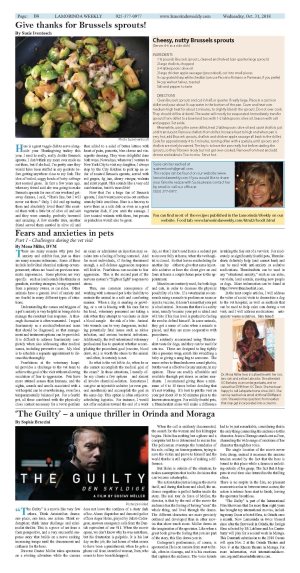| | Published October 31st, 2018
| Fears and anxieties in pets
| | Part 1 - Challenges during the vet visit | | By Mona Miller, DVM |  | | Dr. Mona Miller lives in Lafayette with her son, two cats and yellow Labrador. She attended UC Berkeley as an undergraduate, and received her DVM from UC Davis. She has been happy to call Lafayette home since 2001. She can be reached via email at MonaSDVM@aol.com. She welcomes questions from readers that may get incorporated into a column. |
There are many reasons why pets feel anxiety and exhibit fear, just as there are many reasons in humans. Some of these include individual chemical makeup or temperament; others are based on previous traumatic experiences. Some phobias are very specific - such as loud sounds like thunder or gunshots, meeting strangers, being separated from a primary owner, or car rides. Other animals have a general level of anxiety and are fearful in many different types of situations.
 Understanding the causes and triggers of a pet's anxiety is very helpful in being able to manage the resultant fear response. A thorough discussion is often warranted. I regard fear/anxiety as a medical/behavioral issue that should be diagnosed, so that management and treatment options can be provided. It is difficult to address fear/anxiety completely when also addressing other medical issues, including preventive care. My ideal is to schedule a separate appointment to discuss this thoroughly.
Understanding the causes and triggers of a pet's anxiety is very helpful in being able to manage the resultant fear response. A thorough discussion is often warranted. I regard fear/anxiety as a medical/behavioral issue that should be diagnosed, so that management and treatment options can be provided. It is difficult to address fear/anxiety completely when also addressing other medical issues, including preventive care. My ideal is to schedule a separate appointment to discuss this thoroughly.
 Fearfulness at the veterinary hospital provides a challenge to the vet team to achieve the goal of the visit without allowing escalation of fear to aggression. Pets have more attuned senses than humans, and the sights, sounds and smells associated with a vet hospital can be overwhelming, even for a temperamentally balanced pet. For a fearful pet, all these combined with the physically close contact necessary for a vet to perform an exam or administer an injection may escalate into a feeling of being cornered. And for most individuals, if feeling threatened enough, a self-defense aggression response will kick in. Fearfulness can escalate to fear aggression. This is the second part of the nervous system's "flight or fight" response to stress.
Fearfulness at the veterinary hospital provides a challenge to the vet team to achieve the goal of the visit without allowing escalation of fear to aggression. Pets have more attuned senses than humans, and the sights, sounds and smells associated with a vet hospital can be overwhelming, even for a temperamentally balanced pet. For a fearful pet, all these combined with the physically close contact necessary for a vet to perform an exam or administer an injection may escalate into a feeling of being cornered. And for most individuals, if feeling threatened enough, a self-defense aggression response will kick in. Fearfulness can escalate to fear aggression. This is the second part of the nervous system's "flight or fight" response to stress.
 Thus, one common consequence of working with a stressed pet is the inability to restrain the animal in a safe and comforting manner. When a dog is snarling or growling, or a cat is hissing with his ears flat to his head, veterinary personnel are taking a risk when they attempt to vaccinate or draw a blood sample - the risk of a bite. Animal bite wounds can be very dangerous, including potentially fatal issues such as rabies infection, and serious bacterial infections. Additionally, the well-intentioned veterinary professional has to question whether accomplishing the procedural goal (vaccine, blood draw, etc.) is worth the stress to the animal - and often, it certainly is not.
Thus, one common consequence of working with a stressed pet is the inability to restrain the animal in a safe and comforting manner. When a dog is snarling or growling, or a cat is hissing with his ears flat to his head, veterinary personnel are taking a risk when they attempt to vaccinate or draw a blood sample - the risk of a bite. Animal bite wounds can be very dangerous, including potentially fatal issues such as rabies infection, and serious bacterial infections. Additionally, the well-intentioned veterinary professional has to question whether accomplishing the procedural goal (vaccine, blood draw, etc.) is worth the stress to the animal - and often, it certainly is not.
 So what is the vet left to do, when he or she cannot accomplish the medical goal of the exam? In these situations, I usually offer my clients a few options - and almost all involve chemical sedation. Sometimes I can give an injectable sedative (or even general anesthesia) and accomplish the goal in the same day. This option is often subject to scheduling logistics. For instance, I would not offer sedation toward the end of a work day, so that I don't send home a sedated pet to recover fully at home, when the vet hospital is closed. So that leaves rescheduling for another day - either to give that same injectable sedative or have the client give an oral form at home a couple hours prior to the appointment.
So what is the vet left to do, when he or she cannot accomplish the medical goal of the exam? In these situations, I usually offer my clients a few options - and almost all involve chemical sedation. Sometimes I can give an injectable sedative (or even general anesthesia) and accomplish the goal in the same day. This option is often subject to scheduling logistics. For instance, I would not offer sedation toward the end of a work day, so that I don't send home a sedated pet to recover fully at home, when the vet hospital is closed. So that leaves rescheduling for another day - either to give that same injectable sedative or have the client give an oral form at home a couple hours prior to the appointment.
 Muzzles are routinely used, for both dogs and cats, in order to decrease the physical possibility of a bite. If a veterinarian recommends using a muzzle to perform an exam or inject a vaccine, it doesn't mean that your pet is a bad animal. It means that there's a safety issue, usually because your pet is afraid and will bite if his fear level is pushed to feeling the need to defend himself. In some animals, they get a sense of calm when a muzzle is placed, and they are more cooperative with procedures.
Muzzles are routinely used, for both dogs and cats, in order to decrease the physical possibility of a bite. If a veterinarian recommends using a muzzle to perform an exam or inject a vaccine, it doesn't mean that your pet is a bad animal. It means that there's a safety issue, usually because your pet is afraid and will bite if his fear level is pushed to feeling the need to defend himself. In some animals, they get a sense of calm when a muzzle is placed, and they are more cooperative with procedures.
 I routinely recommend using Thundershirt vests for dogs, and they can be used for cats too. These are designed to hug tightly like a pressure wrap, much like swaddling a baby or giving a snug hug to someone. The name refers to thundershower sound phobia, but the vest is effective for any anxiety, in my opinion. These are readily affordable and available through pet stores or online merchants. I recommend giving these a minimum of 6 to 10 times before deciding that it's not working. It's best to put the vest on your pet about 30 to 60 minutes prior to the known stress trigger. For mildly fearful pets, a Thundershirt alone will make a difference in taking the fear out of a vet visit. For moderately or significantly fearful pets, Thundershirts definitely help (and cannot hurt) and can be used with anti-anxiety or sedative medications. Thundershirts can be used in any "situational anxiety," such as car rides, vet visits, loud sounds, meeting new people or dogs. More information can be found at https://www.thundershirt.com.
I routinely recommend using Thundershirt vests for dogs, and they can be used for cats too. These are designed to hug tightly like a pressure wrap, much like swaddling a baby or giving a snug hug to someone. The name refers to thundershower sound phobia, but the vest is effective for any anxiety, in my opinion. These are readily affordable and available through pet stores or online merchants. I recommend giving these a minimum of 6 to 10 times before deciding that it's not working. It's best to put the vest on your pet about 30 to 60 minutes prior to the known stress trigger. For mildly fearful pets, a Thundershirt alone will make a difference in taking the fear out of a vet visit. For moderately or significantly fearful pets, Thundershirts definitely help (and cannot hurt) and can be used with anti-anxiety or sedative medications. Thundershirts can be used in any "situational anxiety," such as car rides, vet visits, loud sounds, meeting new people or dogs. More information can be found at https://www.thundershirt.com.
 In the next couple articles, I will address the value of social visits to desensitize a dog to the vet hospital; as well as methods that can be used to help calm cats during a vet visit; and I will address medications - anti-anxiety versus sedatives. Stay tuned!
In the next couple articles, I will address the value of social visits to desensitize a dog to the vet hospital; as well as methods that can be used to help calm cats during a vet visit; and I will address medications - anti-anxiety versus sedatives. Stay tuned!

|
| | | | | | | | | | | | |



